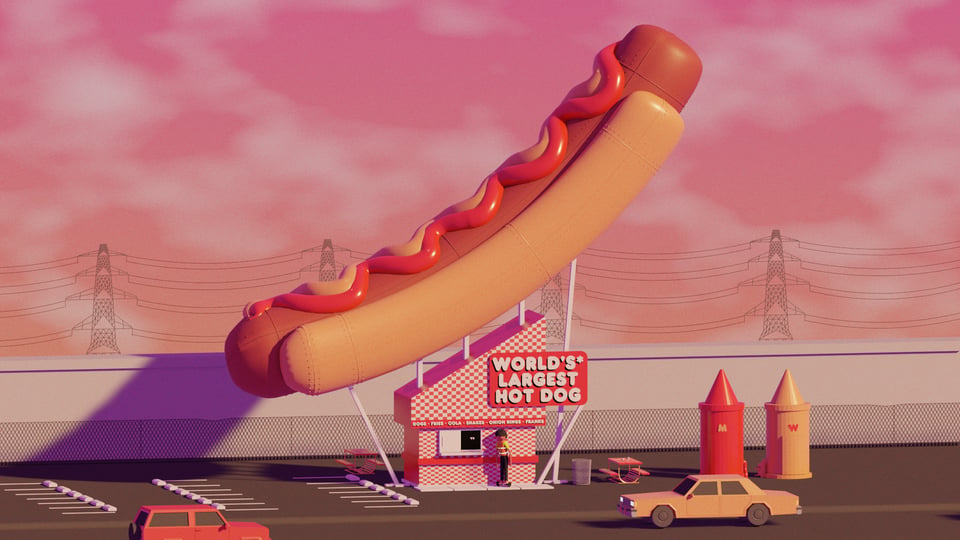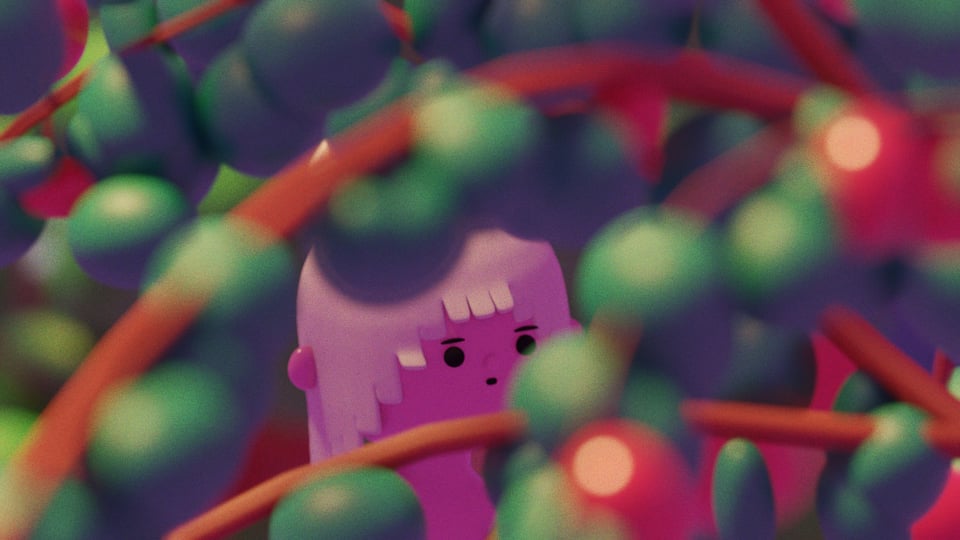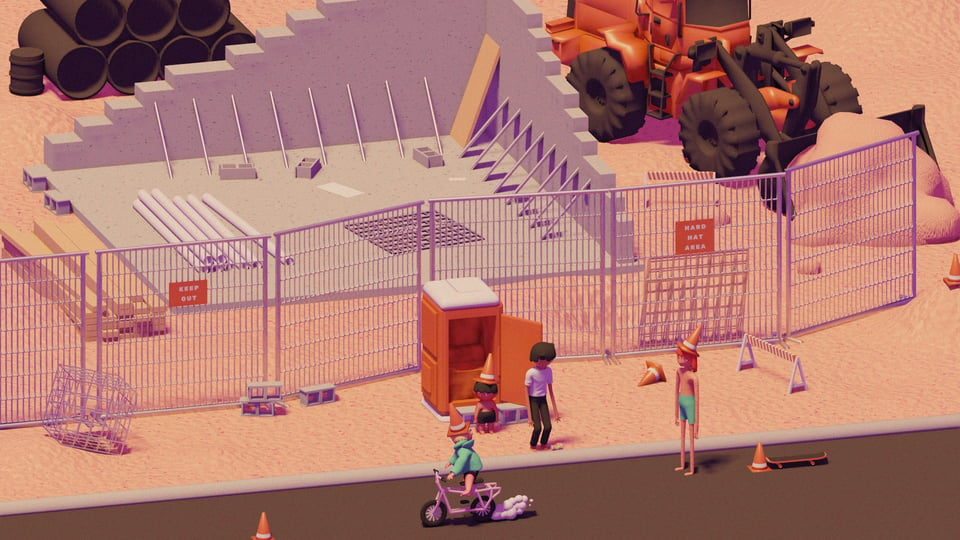Boys Go to Jupiter to avoid walk cycles
Director Julian Glander goes deep on his love of Gumby, economics as religion, and how to hold on to who you are.
by Toussaint Egan

Earlier this month, I had the opportunity to review Boys Go to Jupiter for The A.V. Club. I was (and still am!) really high on the film, having described it as, "an authentic and deeply considered depiction of millennial/Gen Z ennui," that, "taps into the single-minded desperation to escape one's circumstances."
The film follows Billy 5000, a teenage high school dropout living in a suburban town in Florida. Obsessed with making enough money to move out of his sister’s garage, Billy works for a food delivery app called Grubster, speeding across town atop his hoverboard scooter. His life is soon upended by the arrival of an alien creature that escapes from an orange juice factory owned by a nefarious scientist. Faced with a life-changing decision, Billy must decide whether or not money is the real answer to his problems.
The film's director, Julian Glander, is a 3D artist, animator, and musician who has built a multifaceted career for himself, producing animated short films that have garnered online praise and critical recognition, as well as the 2019 video game Art Sqool. I had the privilege to talk to Glander about the earliest inspirations behind his love of art and animation, the origins of Boys Go to Jupiter, and what it means to live, work, and find meaning in our gig economy-addled era.

I read in one of your earlier interviews that Gumby was a huge early inspiration for you, and I definitely can see and feel that through your work. What was it about that character and show that left such a deep impression on you as a young artist and animator?
Julian Glander: Gumby is my 'Rosebud'; it's my core thing. It's just one of those things that was always there for me. I remember having a toy, it was like a plastic Gumby with a wireframe inside of him that I chewed on until I could see the wireframe, and I guess that was the first time I learned what an armature was.
Gumby was obviously created in the '50s, and then he had a bit of a resurgence in the 1980s with some new episodes and a new feature-length film. And in the 1980s, he was more of a rockin' Gumby, like he was in a band with his friends. I was born in 1990, kind of in the aftermath of the world that Gumby had created. I guess I just remember seeing these VHS tapes; I don't know if it was like episodes that my parents had taped, or if they had gotten a box at a garage sale or something.
If I had to intellectualize it, I think he represents the ultimate possibility of animation; the ultimate plasticity, and the fact that he goes into a different world every week. I learned from the Art Clokey documentary that the way they made the first Gumby show was he was also working on, I think it was Davey and Goliath, and they would use leftover sets from Davey and Goliath the following week to make [The Gumby Show].
So it was just like, oh, they had built a construction set, so let's do a Gumby episode where he's in a construction site, or there was a King Arthur set, so let's have Gumby travel to King Arthur's world. I love that approach to animation of just using stuff that's already there and having this perfect character to tell the story. I don't know, I get a tingle when I see Gumby. I think he's just perfect. I love him so much, I'm not sure I can put it into words. He's my guy.
I first encountered your work through Art Sqool back in 2019. With you mentioning how Gumby was in a band, I feel like music is a real defining element of your work as a whole. How did you first get into making music, and have you been listening to anything you want to put people onto?
I started playing the drums growing up, and I was in a marching band. Thinking about music in marching band terms is very similar to animation, I think. There are a lot of elements that overlap. There's the way things are organized on a grid, and then the way a marching band is basically pixel animation with people. I think of my band director creating charts which were basically like key frames for animation, and we were all little pixels of animation.
After that I went to college and I met my producer, Peisin Yang Lazo, who worked on this movie and we moved down to New York and we started a band together. We were playing in this sort of post-punk band in the early 2010s in Brooklyn. I just never really was very good at it. I wasn't a very good songwriter or performer, but I really loved doing it. And I think finding this place to use music where it made sense and complimented the visuals was something that I had been moving towards for a long time.
I'm trying to think what I could put someone onto, because I used to be cool. I don't really keep up with music anymore. You give me a Mitski album every two years, and I'm set. I've been playing this album a lot from the late '90s called Doopee Time by The Doopees [NOTE: The Doopees is a fictional band formed by Japanese composer Yann Tomita to create the ultimate "cute" album]. It has this sort of, like, "we are experimenting in the musical landscape, this music is our lab" vibe that was big in the late '90s that feels very much like Cartoon Network, Adult Swim-like to me. It's a lot of kids singing like, remix cover of classic Doo Wop songs. But the album Doopee Time is something everyone should put on once and see if they like it or not.
I noticed that one of the props in Boys Go to Jupiter, an academic textbook called "Economics Without Economies," appeared in your 2022 short Tennis Ball on His Day Off. The spirit of that film and this one feel so simpatico with one another. Talk me through the connection between these two.
This is deep ball knowledge. So, Tennis Ball on His Day Off was a short that was commissioned by Adult Swim. The structure of it basically is, it's a voicemail that a tennis ball leaves his grandmother. At the time, I was thinking it was going to be the last animated project I ever did. I was so burned out from the pandemic and I was not seeing a future. So I wrote this, almost like a diary entry of the way I was feeling about work, and the way I had given too much of my identity to work, and by telling the story through this tennis ball, I was able to fall in love with animation again. It was a new way of writing for me where I wasn't just thinking about what's going to be entertaining on Instagram or what's going to really go over well on Twitter. I started thinking more about what's personal to me, and it sort of opened up a lot of the things that I needed to work through in a script about my own relationship with work and how much of my identity and myself I had given over to work life.
Tennis Ball on His Day Off is sort of the mother of Boys Go to Jupiter in some ways, but the prop itself was sort of just an act of laziness [laughs]. I reused a few things. Most of the stuff is built from scratch for Boys Go to Jupiter. I put it in the book as a placeholder, and I thought it really worked, but I didn't think anyone would ever catch it. So that's really quite slick.
The hustle culture influencer in that short reminded me a lot of Mr. Moolah, the character Demi Adejuyigbe voices in Boys Go to Jupiter.
Yes, we have Handsome Howie who becomes Mr. Moolah. I think the time-span [of those characters' appearances] between 2022 to 2025 tracks how much more evil and mystical some of this hustle culture has become.
Howie has this "rise and grind" attitude. He has a, "Let's work to become rich" attitude that is kind of a hallmark of 2010 social culture. I think we've moved into something more cosmic, where these ideas from astrology or from mythology have come into our understanding of money. This idea that there's a certain amount of money that we are destined to have, or this idea that there's a certain path to wealth that we can manifest by creating certain vibrations within ourselves. I think that's sort of pervasive throughout the entire movie from talking with Jack [Corbett, who voices Billy 5000] about economics. I started to understand economics as America's religion, and I think each of the characters in this movie have their own denomination of economics that they worship. Y'know, Billy starts in a very straight-up, meritocratic view of working his way up in life.
He comes from a working-class background.
His sister is carrying this belief that his excellence is going to lift the whole family up out of their situation. But I think each character in the movie has some little piece of the puzzle that they can see, and it's a big puzzle that I was trying to wrap my head around too.
It took you roughly nine months to produce Boys Go To Jupiter, from rough animation to final cut. What was the biggest creative hurdle you overcame while making this film, and what was the most surprising challenge you faced?
Oh, I mean there were a ton. This is where my producer and I, we come from this DIY background, and so much of that is just what you do with what you don't have. Y'know, what you do when you've run out of time, or when there's no money, or everyone's saying no to you and the biggest thing was just that I had to keep moving and finish a scene every day for 90 days. And that is where some of the best stuff in the movie comes from.
One that was really hard was at one point in the movie, Sarah Sherman plays a mom in a minivan who runs over one of the kids with her car. And I couldn't get her character in the car the way I needed to. She either looked too small or too big, because a car is something we all know very well. I had drawn it out on a piece of paper and just put a smiley face in the window. And eventually I just looked at that and thought, y'know, what if the 3D version was just her face in the window? What if she actually was the car?

Because that is kind of what it feels like when someone's honking at you and yelling at you. It's like they have almost like, this whole suit of metal around them, and they are the car. And then from that came Julio Torres' character, who is also basically a big building with a face on him. It's almost Thomas the Tank Engine-esque, I guess. That was one. The big one that kind of carries through the whole movie, and a lot of my fellow animators have pointed out, is that nobody walks in the movie.
Walk cycles are oftentimes some of the most expensive, time-consuming elements of an animation project, just because we're all very sensitive to it. We all know what a person walking should look like, and any time I could find some better thing for someone to be doing, whether it was going down an escalator instead of a flight of stairs, or being behind a fence or just shooting up from behind something, I'd do that. My favorite is Billy on the Swagway scooter, because once I put him on that Swagway, which conveniently is very easy to animate, it also gave him a little bit more character-wise. It put him in a very specific time and place, and also informed this motivation of him floating through the world and being a bit ghostly and a bit lost.
You've talked before about how the prominence of wide shots in Boys Go to Jupiter was inspired by you watching Edward Yang's 2000 film Yi Yi. Are there any other live-action directors whose work has inspired you as an animator?
What I love about Yi Yi is you don't even really notice that's happening. Like, they set up these perfect postcards, and then it's like, three or four minutes have gone by and they've done it almost like a stage play where people are coming and going so there's always action. It's very antithetical to, obviously, how movies are shot and edited now, where it's maximum coverage and maximum cuts. I think I said this somewhere else, but we have like 250 cuts in the movie compared to, I don't know, Barbie which has 3,000. But I was in a phase of watching a lot of stuff on Criterion Channel and trying to take one thing from every movie I watched, and from Yi Yi I took there's so much power in just getting the shot right and living there, and it makes it so much easier to feel like you're in the world sometimes.
Obviously, I love Wes Anderson. I love him as an animation director and a live-action director. I was watching a lot of Richard Linklater at the time. The one that really stuck with me is how in Slacker, the way we have this almost invisible watcher that moves through that movie, and it's just catching up with different characters, and they sort of bounce from one to the other, and they're very ideological, and people are very quick to sort of tell you how they feel about the world, which characters do in Boys Go to Jupiter.

There's a line towards the climax of the movie where Rozebud, the love interest played by Miya Folick is like, teasing Billy and she kind of brings him in like she's going to kiss him and then says, "Can you introduce me to your friend? I think I'm in love with them." That was taken from a little piece of Francis Ford Coppola's The Outsiders, where the love interest Cherry does the same thing. She's messing with Pony Boy, and then she says, "I'm in love with your older brother," and it just devastated me when I saw that, because it's such a real teenage feeling. That's one of the more direct cribs. There's maybe a few other parallels with The Outsiders, just this idea of little boys kind of being on their own, which there's a whole lineage of movies like that this one is kind of trying to sneak its way into.
It's funny you say that, I don't even remember Rozebud interacting with Freckles!
Well, there's the moment when Rozebud drops Billy off in front of his house. Freckles is in the driveway, and she gets a little sneak at him. But I also think, this is just a small suburban town where everyone just sort of knows each other. More than actually being in love with Freckles, she's using that moment to sort of twist the knife a bit. She doesn't really care either way.
In your Cartoon Brew interview, you said that Billy's defining choice in the film is that he has to choose between being extremely wealthy and being a good person. As an artist and animator working and living in capitalism, how do you yourself maintain that balance through your art?
This is what's nice about making a movie, is that you get to give someone a clean choice. Billy gets the thing that none of us get, which is he gets to make a decision [to not participate in capitalism]. For most of us, our lives are sort of handed to us from up high or we're given a narrow range of possibilities. I think we all live somewhere in the middle. We all try our best to be of high integrity and at the same time maintain a level of survival.
Billy has a fantastical ending, but I think the message that anyone could take away from the movie is the gig economy, or whatever you want to call it, is trying to take everything from you. They can't take everything. There are things that they can't have that we need to hold on to. And I think the biggest thing that they can't take from us is our ability to be caring and nurturing and to find some small thing in life, whether it's a child or a flower or a pet or a community, to find something to take care of.
Boys Go To Jupiter is showing in theatres: a list of dates and locations can be found here.